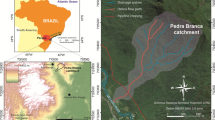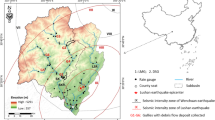Abstract
This paper investigates rapid channelized debris flow related to rainfalls in small alpine basins. Its goal is to evaluate and correlate different geological and technical aspects with predisposing and triggering factors that can control these phenomena. The study area is the upper part of the Susa Valley where 12 small basins were selected. For each of them, lithological, geomorphological, climatic and technical information were mapped and analysed. Debris-flow triggering conditions, flow and depositional processes were related to physical characteristics of the basin that can be easily measured and quantified. At least three different groups of basins were found: G1) basins with one event each 4–6 years, characterised by massive or blocky calcareous rocks, G2) basins with more than one event per year that show an abundance of layered or sheared fine-grained rocks and G3) basins with recurrence levels exceeding 10 years, activated only by heavy and prolonged rainfalls, marked by massive or blocky coarse-grained igneous rocks. Furthermore, important morphometric differences were found. These considerations are useful in terms of hazard zonation and risk mitigation.






















Similar content being viewed by others
References
Alberto W, Carraro F, Giardino M, Tiranti D (2007) Genesis and evolution of “pseudocarniole”: preliminary observations from the Susa Valley (Western Alps)—Geological Society Special Publications, vol 22—evaporites through space and time. The Geological Society, London, UK, pp 271–289
Bardou E, Ancey C, Bonnard C, Vulliet L (2003) Classification of debris flow deposits for hazard assessment in alpine areas. In: Rickenmann, Chen (eds) Debris flow hazard mitigation: mechanics, prediction and assessment. Proceedings of the third international conference on debris-flow, Davos (CH). Millpress, Rotterdam, p 1
Barféty JC, Lemoine M, de Graciansky PC, Tricart P, Mercier D (1996) Carte Géologique de la France à 1:50.000-823. BRGM, Briançon
Baroni C, Bruschi G, Criscuolo A, Mandrone G, Ribolini A (2003) Complete grain-size analyses on debris-flow source area in Carrara marble basino, Apuane Alps, Italy. In: Rickenmann, Chen (eds) Debris flow hazard mitigation: mechanics, prediction and assessment. Proceedings of the third international conference on debris-flow, Davos (CH), Millpress
Bechini R, Cremonini R (2002) The weather radar system of north-western Italy: an advanced tool for meteorological surveillance. Proceedings of ERAD, pp 400–404, Copernicus GmbH
Blair TC, McPherson JG (1994) Alluvial fans and their natural distinction from rivers based on morphology, hydraulic processes, sedimentary processes, and facies assemblages. J Sediment Res A64(3):450–489
Bonnet-Staub I (1998) Définition d’une typologie des dépôts de laves torrentielles et identification de critères granulométriques et géotechniques concernano les zones sources. Bull Eng Geol Environ 57:359–367
Cagnazzi B, Marchisio C (1998) Materials and methods, pluviometry, (excluding particularly intense events), thermometry, climatic classification, climatic map. In: Regione Piemonte (ed) Regional distributions of rainfalls and temperatures. pp 13–75
Fioraso G, Chiarle M (1996) Ruolo dei parametri morfometrici nella valutazione della pericolosità da colata detritica torrentizia. In Luino (ed) La prevenzione delle catastrofi naturali: il contributo della ricerca scientifica. Atti Conv. Int., Alba (IT), pp 191–200
Fratianni S, Motta L (2002) Andamento climatico in alta val susa negli anni 1990–1999. Regione Piemonte (ed) Studi Climatologici in Piemonte (4)
Govi M, Sorzana PF (1980) Landslide susceptibility as a function of critical rainfall amount in Piedmont basin (North-Western Italy). Stud Geomorphol Carpatho Balc 14:43–60
Hoek E, Brown ET (1997) Practical estimates of rock mass strength. Int J Rock Mech Min Sci Geomech Abstr 34(8):1165–1186
Lin CW, Wu MC, Shieh CL (2000) Influence of geology on debris-flows: examples from Hsin-Yi, Nantou County, Taiwan. In: Wieczorek, Naeser (eds) Debris flow hazard mitigation: mechanics, prediction and assessment. Proceedings of the second international conference on debris-flow. Balkema, Taiwan, pp 169–176
Marinos P, Hoek E (2001) Estimating the geotechnical properties of heterogeneous rock masses such as flysch. Bull Eng Geol Env 60:85–92
Moscariello A, Marchi L, Maraga F, Mortara G (2002) Alluvial fans in the Alps: sedimentary facies and processes. Spec Publs Int Ass Sediment 32:141–66
Polino R, Dela Pierre F, Fioraso G, Giardino M, Gattiglio M (2002) Foglio 132-152-153 “Bardonecchia” Carta Geologica d’Italia, scala 1:50,000. Servizio Geologico d’Italia
Tropeano D, Govi M, Mortara G, Turitto O, Sorzana P, Negrini G, Arattano M (1999) Eventi alluvionali e frane nell’Italia Settentrionale. Periodo 1975–1981, CNR-IRPI/GNDCI, Pubbl. n. 1927, p 279
Tropeano D, Turconi L (2002) L’evento del 13 giugno 2000 nelle Alpi Occidentali: effetti sui versanti e nella rete idrografica, CNR-IRPI/GNDCI, Pubbl. n. 2507, Linea 1, p 269
Turner AK (1996) Colluvium and talus. In: Turner AK, Schuster RL (eds) Landslides investigation and mitigation. Special Report 247. Transportation Research Board, National Research Council, Washington, pp 525–549
Wieczorek GF, Glade T (2005) Climatic factors influencing occurrence of debris flow. In: Jacob, Hungr (eds) Debris flow hazard and related phenomena. Springer, pp 325–352
Wieczorek G, Mandrone G, DeCola L (1997) The influence of hillslope on debris-flow initiation. In: Cheg (ed) Debris-Flow hazard mitigation: mechanics, prediction and assessment. Proceedings of the first international conference on debris-flow, San Francisco (USA), pp 21–31
Wieczorek GF, Mc Wreath HC, Davenport C (2001) Remore rainfall sensing for landslide hazard analysis. US Geological Survey Open-File Report 01-339, 11 p
Wilford DJ, Sakals ME, Innes JL, Sidle RC, Bergerud WA (2004) Recognition of debris flow, debris flood and flood hazard through watershed morphometrics. Landslides 1:61–66
Acknowledgements
Special thanks to Andrea Moscariello for suggestions on methods, to Roberto Cremonini for his indispensable contribution to weather radar data processing and to Davide Rabuffetti for suggestion on hydrological analysis. Davide Tiranti was responsible for geological-sedimentological observations and climatic studies; Sabrina Bonetto took care of laboratory analysis and statistical processing; Giuseppe Mandrone of geotechnical and geomechanical considerations, of the supervising and of the final editing of the paper.
Author information
Authors and Affiliations
Corresponding author
Rights and permissions
About this article
Cite this article
Tiranti, D., Bonetto, S. & Mandrone, G. Quantitative basin characterisation to refine debris-flow triggering criteria and processes: an example from the Italian Western Alps. Landslides 5, 45–57 (2008). https://doi.org/10.1007/s10346-007-0101-4
Received:
Accepted:
Published:
Issue Date:
DOI: https://doi.org/10.1007/s10346-007-0101-4




